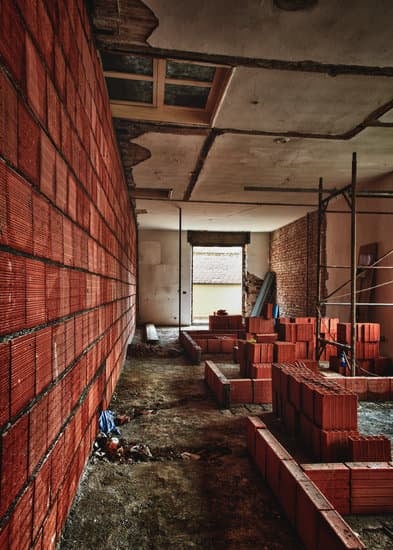The concept of depreciation on home improvements is an important topic for homeowners to understand. When making upgrades or renovations to a property, it’s crucial to be aware of how these changes may affect the value of the home over time. This section will provide a comprehensive introduction to this concept, exploring what depreciation is and why it applies specifically to home improvements.
Depreciation, in simple terms, refers to the decrease in value that occurs over time for an asset. In the context of home improvements, it means that certain upgrades or renovations may lose value as they age or become outdated. Understanding depreciation is essential for homeowners because it can impact their investment decisions and overall financial planning.
In this article, we will delve into the definition of depreciation and its significance in relation to home improvements. We will explore the factors that influence depreciation on these projects and discuss how accurate cost estimation plays a vital role in assessing depreciation. Additionally, we will shed light on the tax implications and benefits associated with depreciation on home improvements.
By gaining a deeper understanding of this concept, homeowners can make more informed decisions regarding their investments in home improvements and take steps to minimize depreciation. Throughout the article, we will provide tips and strategies for protecting your investment against devaluation. Real-life case studies will illustrate different scenarios where depreciation has occurred on various home improvement projects.
Finally, expert insights from tax consultants will be shared through an interview segment, providing valuable information on how depreciation applies specifically to home improvements. And we’ll wrap up with frequently asked questions about this topic, addressing any doubts or concerns readers may have.
Overall, this article aims to empower homeowners with knowledge and tools for making informed decisions about depreciation on their home improvements, ultimately helping them protect their investment and maximize the value of their properties.
Definition of Depreciation
Depreciation is the decrease in value of an asset over time due to wear and tear, obsolescence, or other factors. In the context of home improvements, depreciation refers to the reduction in value that occurs to the improvements made on a property. This can happen for various reasons and understanding why it applies to home improvements is crucial for homeowners.
When you make improvements to your home, such as remodeling the kitchen or adding a new bathroom, you may expect that these upgrades will increase the overall value of your property. However, over time, these improvements may start to lose their value due to factors such as normal wear and tear, changing trends and styles, or technological advancements.
For example, if you install high-end appliances in your kitchen today, they may be considered top-of-the-line now but become outdated and less desirable in several years. In addition, certain features or styles that were once popular may go out of fashion or become obsolete. As a result, the value of those home improvements may depreciate.
It’s important to note that not all home improvements depreciate at the same rate. Some projects hold their value better than others. For instance, structural upgrades like replacing roofs or windows tend to have a longer lifespan and experience slower depreciation compared to cosmetic enhancements like painting walls or installing decorative lighting fixtures.
Understanding these factors is essential when planning home improvement projects because it allows homeowners to make informed decisions about where they allocate their resources and how much they can expect these investments to depreciate over time. By considering both short-term aesthetic appeal and long-term durability and functionality, homeowners can better manage the potential depreciation of their home improvements.
Factors Influencing Depreciation on Home Improvements
When it comes to depreciation on home improvements, there are several key factors that influence how much value is lost over time. These factors can range from the type of material used to the quality of the workmanship. Understanding these elements is crucial for homeowners who want to make informed decisions about their investments.
- Materials Used: The choice of materials plays a significant role in determining the depreciation rate of home improvements. Certain materials such as wood or carpeting may be more prone to wear and tear, resulting in a faster depreciation rate compared to materials like ceramic tiles or hardwood floors. It’s important to consider durability and longevity when selecting materials for your home improvement projects.
- Quality of Workmanship: The quality of workmanship can greatly impact the depreciation rate of home improvements. Poorly executed renovations or repairs may not only affect the overall functionality and appearance of the project but also contribute to higher rates of depreciation. Hiring reputable contractors or skilled professionals ensures that the work is done correctly, increasing the longevity and value retention of your home improvements.
- Maintenance and Upkeep: Regular maintenance and upkeep are crucial in preventing accelerated depreciation on home improvements. Neglecting necessary repairs or failing to properly maintain your newly improved areas can lead to premature deterioration and decreased value over time. It is important to establish a routine maintenance schedule and address any issues promptly to prolong the lifespan and value of your investment.
By considering these key elements, homeowners can make more informed decisions when planning their home improvement projects. Selecting durable materials, ensuring high-quality workmanship, and prioritizing regular maintenance will help minimize depreciation rates on your investments, ultimately maximizing their long-term value.
Assessing the Lifespan of Different Home Improvement Projects
When planning home improvement projects, it is essential to consider their lifespan and how they may depreciate over time. Not all home improvements are created equal, and some may lose their value more quickly than others. Understanding which projects depreciate the most can help homeowners make informed decisions about where to invest their time, money, and effort.
One of the primary factors that play a significant role in the depreciation of home improvements is changing trends and styles. What might be considered modern and desirable today could become outdated tomorrow, leading to a decrease in market value. For example, trendy kitchen designs with bold colors or unique materials may lose their appeal over time as new styles emerge. On the other hand, classic designs that stand the test of time tend to hold their value better.
Another factor impacting depreciation is technological advancements. As technology continues to advance at a rapid pace, certain home improvements may become obsolete quicker than others. For instance, installing high-tech audiovisual systems or wiring your home for automation might seem like a great investment initially but could become outdated within a few years as newer technologies emerge.
| Home Improvement Project | Average Lifespan |
|---|---|
| Kitchen Renovation | 10-15 years |
| Bathroom Remodel | 10-15 years |
| Roof Replacement | 20-30 years |
| Deck Addition | 10-15 years |
| Flooring Replacement | 10-20 years |
| Window Replacement | 15-20 years |
While these average lifespans can provide guidance, it is essential to note that the actual lifespan of a home improvement project can vary based on various factors such as quality of materials used, maintenance, and local market conditions. Additionally, regular maintenance and upgrades can help extend the lifespan of certain projects.
By being aware of which home improvement projects tend to depreciate more quickly, homeowners can make informed decisions when planning renovations. It is crucial to strike a balance between personal preferences and long-term value. Opting for timeless designs and durable materials may help mitigate depreciation and maximize the return on investment in the long run.
Importance of Accurate Cost Estimation
Accurate cost estimation plays a crucial role in determining the depreciation on home improvements. When homeowners embark on a home improvement project, they need to have a clear understanding of the costs involved, as these costs directly influence the amount of depreciation that can be claimed. Inaccurate or underestimated cost estimations can result in decreased depreciation deductions and potential financial loss for homeowners.
Factors Affecting Accurate Cost Estimation
Several factors contribute to accurate cost estimation for home improvements. Firstly, it is essential to consider the quality of materials used, as higher-quality materials often have a longer lifespan and depreciate at a slower rate compared to lower-quality materials. Additionally, labor costs and any additional expenses such as permits or professional fees should be taken into account when estimating the overall cost of the project.
Importance of Detailed Records
Keeping detailed records is vital when it comes to accurate cost estimation and claiming depreciation on home improvements. Homeowners should maintain receipts for all expenses related to the improvement project, including materials, labor costs, and any other relevant expenses. These records serve as evidence during tax filings and ensure that homeowners can claim the appropriate amount of depreciation based on the actual costs incurred.
Budget Considerations
Accurate cost estimation also helps homeowners plan their budget effectively. By knowing the anticipated costs upfront, homeowners can make informed decisions about which improvements are feasible within their budgetary constraints. It allows them to prioritize home improvement projects based on their financial capacity and avoid going overboard with unnecessary expenses.
Understanding the Tax Implications
Depreciation on home improvements can have significant tax implications for homeowners. Understanding these implications is essential in order to make informed decisions about home improvement projects and maximize potential benefits. This section will delve into the tax aspects of depreciation on home improvements and how it can benefit homeowners.
One of the key benefits of depreciation on home improvements is the ability to deduct a portion of the cost from your taxable income. The Internal Revenue Service (IRS) allows homeowners to depreciate certain eligible improvements over a period of time, typically 27.5 years for residential properties. This means that you can spread out the deduction over several years, effectively reducing your annual tax liability.
To take advantage of this tax benefit, it is necessary to accurately determine the depreciable basis of the improvement. The depreciable basis includes not only the cost of materials and labor but also any additional expenses incurred during the improvement process, such as permits or professional fees. It is important to keep detailed records and documentation to support your depreciable basis in case of an audit.
Another way depreciation on home improvements can benefit homeowners is through potential capital gains tax savings when selling the property. Improvements that have been depreciated may reduce your overall taxable gain when you sell the property. However, it is important to note that there are certain limitations and requirements regarding depreciation recapture when selling a property, so consulting with a tax professional is recommended.
In order to fully understand and take advantage of the tax implications of depreciation on home improvements, homeowners should consult with a qualified tax professional or accountant who specializes in real estate taxation. They can provide personalized advice based on your specific situation and help you navigate through complex tax laws and regulations related to depreciation.
Overall, understanding the tax implications of home improvement depreciation can be beneficial for homeowners looking to minimize their tax liability and maximize their return on investment. By taking advantage of allowable deductions and properly documenting expenses, homeowners can potentially save money in taxes and make their home improvement projects more financially advantageous in the long run.
Tips and Strategies to Minimize Depreciation on Home Improvements
Regular Maintenance and Upkeep
One of the key strategies to minimize depreciation on home improvements is to prioritize regular maintenance and upkeep. A well-maintained home not only retains its value but also helps preserve the condition of any improvements made. This includes tasks such as cleaning gutters, replacing filters, inspecting for leaks or cracks, and ensuring proper ventilation. By addressing minor issues promptly, homeowners can prevent them from escalating into major problems that could lead to significant depreciation.
It is also important to establish a preventative maintenance schedule for various systems and components within the home. This can include regular servicing of HVAC systems, checking plumbing for leaks, inspecting the roof for damage, and maintaining landscaping. Taking these proactive measures can extend the lifespan of home improvements and minimize the effects of depreciation over time.
Quality Materials and Professional Installation
Another important factor in minimizing depreciation on home improvements is using quality materials and ensuring professional installation. Cutting corners by opting for cheaper materials or attempting DIY installations might seem cost-effective in the short term but may result in greater depreciation over time.
Investing in high-quality materials that are durable and resistant to wear can help prolong the lifespan of home improvements. Additionally, hiring experienced professionals for installation ensures that work is done correctly according to industry standards. Faulty installations or subpar craftsmanship can lead to premature deterioration of improvements and decrease their overall value.
Consider Timeless Design Elements
When planning for home improvements, it is advisable to consider timeless design elements rather than following fleeting trends. Trends come and go, which means that trendy designs may quickly become outdated and less appealing to potential buyers in the future. By opting for classic design elements that stand the test of time, homeowners can maintain the value of their investments.
Timeless design elements include neutral color schemes, versatile flooring options such as hardwood or tile, and fixtures with a timeless appeal. These choices not only enhance the aesthetic appeal of the home but also contribute to its long-term value. It is important to strike a balance between personal style and design choices that have broader appeal, ensuring that the home improvements will retain their value over time.
Case Studies
In this section, we will delve into real-life examples to provide a better understanding of how depreciation can affect different home improvement projects.
Example 1: Kitchen Renovation
Let’s take a look at a case study involving a kitchen renovation. The homeowner invested $30,000 in upgrading the cabinets, countertops, and appliances. According to experts, the average lifespan of a kitchen renovation is around 15 years. Using the straight-line depreciation method, the annual depreciation for this project would be approximately $2,000 ($30,000 divided by 15 years). This means that each year, the homeowner can deduct $2,000 from their taxes as depreciation expense.
Example 2: Bathroom Remodel
Now, let’s consider a bathroom remodel case study. The homeowner spent $20,000 on renovating their bathroom by replacing fixtures, tiles, and plumbing. Bathrooms typically have an average lifespan of around 10-15 years. If we assume a conservative estimate of 12 years for this particular renovation project and apply straight-line depreciation, the annual deduction for depreciation would be roughly $1,667 ($20,000 divided by 12 years).
Example 3: Roof Replacement
Lastly, let’s examine the case of a roof replacement. The homeowner decided to replace their old roof with a new one at a cost of $10,000. Roofs generally have an average lifespan ranging between 20-25 years. If we take a moderate estimate of 22 years for this scenario and use straight-line depreciation calculation methods, the annual depreciation deduction would amount to approximately $455 ($10,000 divided by 22 years).
These case studies illustrate how various home improvement projects can experience depreciation over time. It is important to note that these are simplified examples and actual calculations may differ based on specific circumstances such as local market conditions or quality of materials used.
However, they provide valuable insights for homeowners to better understand and anticipate the potential depreciation on their own home improvement projects. By knowing the estimated lifespan of different renovations as well as the associated depreciation expenses, homeowners can plan their investments more effectively and make informed decisions about timing and budgeting for future improvements.
Expert Insights
In this section of the article, we will provide expert insights through an interview with a tax consultant who specializes in depreciation and its application to home improvements. This interview will offer valuable information and tips for homeowners looking to understand the tax implications of home improvement depreciation.
- Interviewer: Thank you for joining us today. Can you start by explaining what depreciation is in the context of home improvements?
- Tax Consultant: Of course. Depreciation, in simple terms, refers to the decrease in value that occurs over time due to wear and tear, age, or obsolescence. When it comes to home improvements, depreciation is applied because these improvements are considered to have a limited lifespan. Over time, they lose value and can no longer be fully recovered in case of a sale.
- Interviewer: What are some key factors that influence the rate at which home improvements depreciate?
- Tax Consultant: Several factors come into play when determining the rate of depreciation on home improvements. The quality of materials used, the method of construction or installation, as well as regular maintenance all affect how quickly an improvement loses value. Additionally, the location and overall condition of the property also influence depreciation rates.
- Interviewer: How can accurate cost estimation impact depreciation on home improvements?
- Tax Consultant: Accurate cost estimation is crucial when it comes to assessing depreciation on home improvements. Higher initial costs do not necessarily mean slower depreciation. If an improvement is costly but has a short life expectancy or low maintenance requirements, it may still depreciate quickly. Conversely, a less expensive improvement with better materials and longevity may have a slower rate of depreciation.
| Factors Influencing Depreciation | Examples |
|---|---|
| Quality of Materials | High-quality materials tend to depreciate at a slower rate compared to lower quality ones. |
| Method of Construction or Installation | Properly installed improvements tend to have a slower depreciation rate. |
| Regular Maintenance | Consistent maintenance can slow down the depreciation process of home improvements. |
| Location and Overall Condition of the Property | The condition and desirability of the property’s location can impact the depreciation rate. |
Frequently Asked Questions (FAQs) about Home Improvement Depreciation
What is home improvement depreciation?
Home improvement depreciation refers to the reduction in value that occurs over time on home improvement projects. When homeowners make improvements to their homes, such as renovating a kitchen or adding a new bathroom, the value of these improvements may decrease over time due to various factors. Depreciation can significantly impact the overall value of a property and understanding how it works is crucial for homeowners.
Why does home improvement depreciation occur?
Home improvement depreciation occurs due to several factors. Firstly, wear and tear on materials and components used in the project can lead to a decrease in value. For example, countertops may become chipped or scratched over time, reducing their aesthetic appeal and thus their value.
Secondly, changes in design trends can render certain improvements outdated or less desirable, causing them to depreciate. Lastly, external factors such as economic conditions or location-specific market trends can also contribute to the depreciation of home improvements.
How can homeowners minimize depreciation on home improvements?
While depreciation is inevitable with most home improvements, there are steps homeowners can take to minimize its impact. One effective strategy is to carefully choose durable and high-quality materials that are less likely to show signs of wear and tear quickly.
Additionally, following timeless design principles rather than chasing trends can help ensure that home improvements remain relevant and valuable for longer periods. Regular maintenance and upkeep are also essential in preserving the condition of home improvements and minimizing depreciation.
It’s important for homeowners to understand how depreciation on home improvements works so they can make informed decisions about their investments. By considering factors influencing depreciation, assessing project lifespans accurately, understanding tax implications, and adopting strategies to minimize depreciation, homeowners can protect their investment and potentially increase the overall value of their property over time.
Conclusion
In conclusion, understanding the concept of depreciation on home improvements is crucial for homeowners to make informed decisions. Depreciation refers to the decrease in value that occurs over time due to wear and tear, obsolescence, or other factors. It is important to note that not all home improvements depreciate at the same rate, and factors such as materials used, quality of workmanship, and market demand can influence the rate of depreciation.
Assessing the lifespan of different home improvement projects is essential in determining how much they will depreciate. Projects that have a shorter lifespan, such as appliances or decorative upgrades, tend to depreciate more quickly compared to projects with a longer lifespan, such as structural renovations. Therefore, it is important for homeowners to prioritize investments based on their personal preferences and long-term goals.
Accurate cost estimation also plays a significant role in understanding depreciation on home improvements. Underestimating costs can lead to subpar materials or rushed workmanship, which may result in faster depreciation. On the other hand, investing in high-quality materials and skilled labor can help extend the lifespan of home improvements and minimize depreciation.
Considering the tax implications can also benefit homeowners when dealing with depreciation on home improvements. Depending on local laws and regulations, homeowners may be able to deduct certain expenses related to home improvements from their taxes. Consulting with a tax professional can provide valuable insights into maximizing these benefits.
To protect their investment and minimize depreciation on home improvements, homeowners should follow tips and strategies such as regular maintenance, choosing durable materials, and keeping documentation of all improvement projects. Learning from real-life case studies and seeking expert insights from consultants can also provide additional guidance in making informed decisions.
Frequently Asked Questions
How do you depreciate home improvements?
Home improvements can be depreciated over a period of time using the straight-line method. This involves dividing the cost of the improvement by its useful life, which is determined by the IRS. The useful life differs for different types of home improvements, with some having more extensive and longer-lasting benefits than others.
For example, a major renovation like installing a new roof may have a longer useful life than replacing outdated appliances. By spreading out the cost of improvements over their useful life, homeowners can deduct a portion of their value each year on their taxes.
How many years do you depreciate renovations?
The number of years you can depreciate renovations depends on the type of improvement made to your home. Generally, most home renovations have a depreciable life ranging from 5 to 27.5 years.
For instance, if you renovate your kitchen or bathroom with new cabinets and fixtures, these improvements are typically considered to have a useful life of 15 years. However, it’s worth noting that some renovations may not be eligible for depreciation if they are considered routine repairs or maintenance rather than capital improvements that enhance the value or extend the lifespan of your home.
How much home depreciation can you write off?
The amount of home depreciation you can write off varies depending on several factors, including your personal use percentage and whether you use your home for both personal and rental purposes. If you solely use your home as your primary residence and don’t rent it out in any capacity, you generally cannot deduct any depreciation expenses associated with home improvements for tax purposes.
However, if you do rent out part or all of your property or use it for business purposes, then allowable depreciation can be deducted from rental income or business profits when reporting taxes. It’s important to consult with tax professionals or refer to official IRS guidelines to ensure accurate calculation and reporting of allowable depreciation deductions based on your specific circumstances.

I’m thrilled to have you here as a part of the Remodeling Top community. This is where my journey as an architect and remodeling enthusiast intersects with your passion for transforming houses into dream homes.





